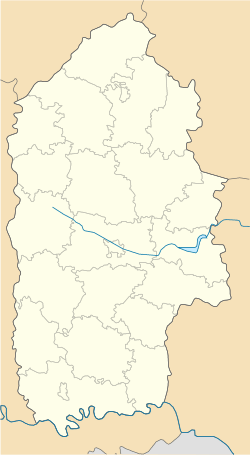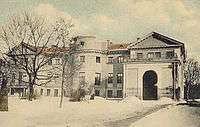Slavuta
| Slavuta Славута | |||
|---|---|---|---|
|
Slavuta, Khmelnitskyi Oblast | |||
| |||
 Slavuta Location in Khmelnytskyi Oblast | |||
| Coordinates: 50°18′10″N 26°52′06″E / 50.30278°N 26.86833°E | |||
| Country |
| ||
| Oblast |
| ||
| Raion | Slavutskyi Raion | ||
| First mention date | XVII | ||
| City rights | 1633 | ||
| Government | |||
| • Mayor | Vasyl B. Sydor | ||
| Area | |||
| • Total | 20 km2 (8 sq mi) | ||
| Population (2011) | |||
| • Total | 35,442 | ||
| • Density | 1.772/km2 (4.59/sq mi) | ||
| Time zone | EET (UTC+2) | ||
| • Summer (DST) | EEST (UTC+3) | ||
| Postal code | 30000 | ||
| Area code(s) | +380 3842 | ||
| Website | http://www.slavuta-mvk.info/ | ||
Slavuta (Ukrainian: Славута, Russian: Славу́та, Polish: Sławuta, Yiddish: סלאוויטא, translit. Slavita) is a city of oblast subordinance in the Khmelnytskyi Oblast (province) of western Ukraine, located on the Horyn River. Serving as the administrative center of the Slavutskyi Raion (district), the city itself is also designated as a separate raion within the oblast, and is located approximately 80 km from the oblast capital, Khmelnytskyi, at around 50°18′N 26°52′E / 50.300°N 26.867°E. The city's population is 35,442 (Jan. 1, 2011).[1]
History
Located in Volhynia, Slavuta was founded by a member of Zaslawski family in 1633. As the family extinguished, all its possessions were transferred to Lubomirski family. Eventually the town was passed on to Marianna Lubomirska who married Pawel Sanguszko who turned the town into the family seat of the Sanguszko princes.
Between 1922 and 1939 it was on the Soviet border with Poland.
In 1791 the Szapira family set up a Hebrew printing press in Slavuta, which published an influential edition of the Talmud. Moshe Feldenkrais was born in Slavuta on May 6, 1904.[2]
Jewish history
Slavuta has a rich Jewish history. The town had a prominent Jewish community since near its establishment in the 1600's. The peak of the Jewish population of Slavuta is over 5100 in 1939, about 1/3 of the town's population. In the late 1890's the Jewish population of Slavuta was near 60% at 4900 people.
The Jewish community consisted of farmers, traders, storekeepers, and rabbinical teachers. Slavuta at one point had nearly 200 Jewish owned shops, largely due to Slavuta being established as a prominent trading town and Jewish center. Slavuta also had three established synagogues.
With WWII and the invasion of Nazis, the Jews of Slavuta had a fate similar as the Jews of hundreds of other villages near and far. Fortunately, many hundreds were able to flee to Tashkent and Siberia. But, over 2000 Jews were killed in the Slavuta ghetto and concentration camp. All but one synagogue remained, and the mass grave of Jews killed was left in a field.
After WWII, Slavuta still had a sizable Jewish community. The survivors of the ghetto and concentration camp, the Jews who fled to Siberia and Tashkent, as well as surviving Jews from surrounding villages that had been completely destroyed resettled in Slavuta. Synagogue papers, furniture, and scripts from the surrounding ravaged communities had been brought to the Slavuta synagogue. Slavuta also had many monuments established, dedicated to the Jews killed during WWII. Today, nearly 700 Jews remain in Slavuta. [3]
Famous residents
- Henryk Rzewuski was a Polish Romantic-era journalist and novelist.
- Evsei Liberman was a Soviet economist.
- Moshé Feldenkrais physicist and the founder of the Feldenkrais Method, designed to improve human functioning by increasing self-awareness through movement.
- Oleksandr Zinchenko was a Ukrainian politician who was Director-General of the National Space Agency of Ukraine from 2009 to 2010.
- Family Sanguszko (Belarusian: Сангушка, Ukrainian: Сангушко) is a Polish-Lithuanian noble family of the Ruthenian (now Ukrainian) stock from the Gediminid dynasty. Like other princely houses of Polish-Lithuanian Commonwealth.
- Eustachy Erazm Sanguszko was a Polish general and politician.
- Roman Sanguszko was a Polish aristocrat, patriot, political and social activist.
- Roman Damian Sanguszko, public and political leader, industrialist and landowner, collector.
Gallery
- Orthodox church in Slavuta
- Church of St. Dorothy
- Car monuments in downtown Slavuta
- Church of Nativity of the Theotokos
- Soviet World War II monument in Slavuta
 Sanguszko Palace
Sanguszko Palace
See also
References
External links
- The official site (in Ukrainian)
- City Slavuta (in Ukrainian)
- Department of Education Slavuta (in Ukrainian)
- The discount card Verkhovna Rada of Ukraine (in Ukrainian)
- History of Jewish Community in Slavuta
| Wikimedia Commons has media related to Slavuta. |

